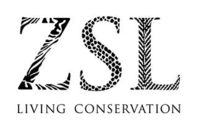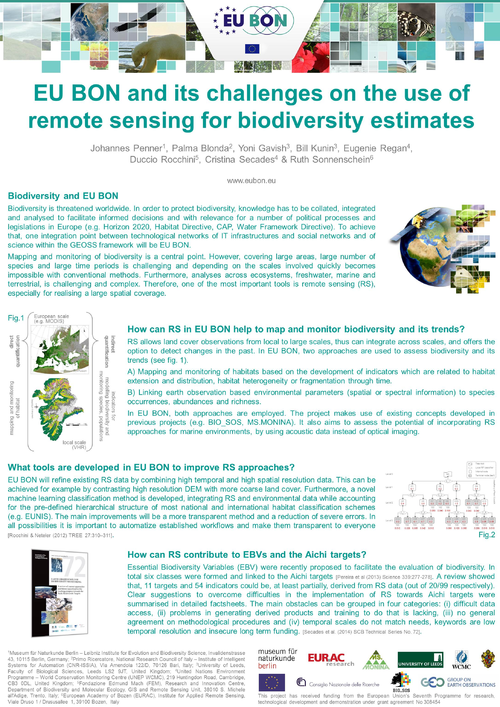04.06.2014
Symposium (22-23 May): Remote Sensing for Conservation, London, UK

On 22nd and 23rd of May a symposium entitled "Remote sensing for conservation: uses, perspectives and challenges" took place at the Zoological Society of London (ZSL). The organisers successfully aimed at linking specialists from the two fields, remote sensing and conservation, more tightly. The two days provided a great overview of current activities of joint approaches and glimpses of what might be possible in the near future. In the following, a short subjective overview of the highlights is given with relevance to EU BON.
 The first day started with the welcoming notes by the ZSL and the news that a new journal, which is especially created for the interplay between remote sensing and conservation, will be published soon. Woody Turner (NASA) gave a fabulous keynote with examples of current state of the art studies, such as using drones and off the shelf cameras to get cheap custom designed aerial images, the impressive combination of radar data with hyperspectral bands which lead to a 3D image of forest biodiversity and the emerging use of bioacoustics to monitor biodiversity. Nathalie Pettorelli (ZSL) gave an introduction into NDVI (Normalized Differenced Vegetation Index) and an overview of its usefulness for conservation. Martin Wegmann (University of Würzburg, DLR) showed the usefulness of a variety of fragmentation indices. Thomas Esch (DLR) showed the current status of the upcoming global urban footprint. Diane Davies (NASA) listed and compared a number of sources which monitored fires on a regional and global scale. Frank Muller-Karger (University of South Florida) elaborated on his enormous efforts to create global "seascapes" comparable to landscapes or ecoregions and his ultimate goal, a global marine biodiversity observation network (mbon). Temilola Fatoyinbo (NASA) explained the efforts towards a comprehensive global assessment of mangroves. Peter Reinartz (DLR) tested whether space born animal tracking is possible, and it will be.
The first day started with the welcoming notes by the ZSL and the news that a new journal, which is especially created for the interplay between remote sensing and conservation, will be published soon. Woody Turner (NASA) gave a fabulous keynote with examples of current state of the art studies, such as using drones and off the shelf cameras to get cheap custom designed aerial images, the impressive combination of radar data with hyperspectral bands which lead to a 3D image of forest biodiversity and the emerging use of bioacoustics to monitor biodiversity. Nathalie Pettorelli (ZSL) gave an introduction into NDVI (Normalized Differenced Vegetation Index) and an overview of its usefulness for conservation. Martin Wegmann (University of Würzburg, DLR) showed the usefulness of a variety of fragmentation indices. Thomas Esch (DLR) showed the current status of the upcoming global urban footprint. Diane Davies (NASA) listed and compared a number of sources which monitored fires on a regional and global scale. Frank Muller-Karger (University of South Florida) elaborated on his enormous efforts to create global "seascapes" comparable to landscapes or ecoregions and his ultimate goal, a global marine biodiversity observation network (mbon). Temilola Fatoyinbo (NASA) explained the efforts towards a comprehensive global assessment of mangroves. Peter Reinartz (DLR) tested whether space born animal tracking is possible, and it will be.
On the second day Thomas Nauss (University of Marburg) started by delving into LiDAR (light detection and ranging; meaning the use of an active sensor measuring the reflectance of short laser pulses), derived not only from aerial flights but also from on-ground measurements. Kamran Safi (MPI Radolfzell) presented the awesome analysis of movement ecology and the incorporation in conservation. Graeme Buchanan (RSPB) presented nice examples of successful predictive ENMs (environmental niche models). Carlo Rondinini (University of Rome) tested the role of protected areas for large mammals in Africa. Andrew Skidmore (University of Twente) called for a need for more fine grained data and the inclusion of a more agricultural centred perspective because of a large percentage of the land surface is under agricultural use. Edward Mitchard (University of Edinburgh) showed exemplarily a study of REDD+ (revised programme of Reducing Emissions from Deforestation and Degradation) in Indonesia. Gregoire Dubois (EC-JRC) presented the current state and future steps of DOPA (Digital Observatory for Protected Areas). Robert Rose (WCS) gave an insight into the joint platform for remote sensing and conservationists (CRSNet) and the top 10 conservation questions derived from a joint project. Finally Mike Gill (Environment Canada) illuminated the GEO BON mission and Christina Secades (WCMC) gave some details of her report on the usefulness of remote sensing for the Aichi targets.
Posters were exhibited as well. EU BON presented its remote sensing approaches and Palma Blonda (CNR-ISSIA) the BIO_SOS project. Two poster highlights were the announcement of a "temporal human impact index" by Jonas Geldmann (University of Copenhagen) and the "Biodiversity Indicators Dashboard", a facilitated interpretation of biodiversity indicators using the Tropical Andes, the African Great Lakes, and the Mekong Basin as examples (http://www.natureserve.org/conservation-tools/projects/biodiversity-indicators-dashboard).
Please lind attached below the a list of the projects and articles (with links) which were mentioned during the talks and which I found interesting (in no particular order or relevance!)




 RSS news
RSS news Interesting projects and articles
Interesting projects and articles Print this article
Print this article
